Tizado malinterpretado
Moderador: Rein
- Rein
- Usuario Colaborador

- Mensajes: 6258
- Registrado: 13 Mar 2009 15:59
- Ubicación: Leiden, Netherlands
- Contactar:
Tizado malinterpretado
The 3 commemorative stamps issued at the end of 1941 have always been considered "papel tizado" by Victor Kneitschel. Klass (1970) does likewise! But Mello Teggia does not use the word "tizado" at all in that period! Only the 1939 UPU Congress is referred to as Tizado by MT! Göttig-Jalil consider Roca and the National Bank to be on coated paper BUT not Lavalle!
1941 19.10 Julio A. Roca c/v TI 1?
1941 26.10 Banco de la Nación MI 3?
1941 05.12 Lavalle MI 3?
All 3 stamps in photogravure with an orthogonal watermark reminescent of that of the Holandés or Stinnes paper! Paper mesh symmetrical and the direction of paper parallel to the long side of the stamps!
So far I had considered only Roca to be on coated paper! But I have my doubts now! This is partly due to what I have seen but also thanks to the study made by Guillermo Sosa of the 5c Moreno!
The notion "c/v" meaning coated and/or varnished was mine from the beginning as I had the impression that this stamp had probably been varnished and nothing more! José Merlo stated in a PM that he had understood from the Casa de Moneda that they had never used the process of varnishing... I am afraid I will not buy that!
Another aspect of the Roca stamps is the existence of two different directions of printing !!! Both L and R occur!! What does that tell us?? All major catalogues refer to two different composiciones! That is TWO panes of 10x10 maybe have a tête-bête lay-out...
to be continued ...
1941 19.10 Julio A. Roca c/v TI 1?
1941 26.10 Banco de la Nación MI 3?
1941 05.12 Lavalle MI 3?
All 3 stamps in photogravure with an orthogonal watermark reminescent of that of the Holandés or Stinnes paper! Paper mesh symmetrical and the direction of paper parallel to the long side of the stamps!
So far I had considered only Roca to be on coated paper! But I have my doubts now! This is partly due to what I have seen but also thanks to the study made by Guillermo Sosa of the 5c Moreno!
The notion "c/v" meaning coated and/or varnished was mine from the beginning as I had the impression that this stamp had probably been varnished and nothing more! José Merlo stated in a PM that he had understood from the Casa de Moneda that they had never used the process of varnishing... I am afraid I will not buy that!
Another aspect of the Roca stamps is the existence of two different directions of printing !!! Both L and R occur!! What does that tell us?? All major catalogues refer to two different composiciones! That is TWO panes of 10x10 maybe have a tête-bête lay-out...
to be continued ...
Re: Tizado malinterpretado
Rein,
You can rest assured that 5c Roca is tizado. For your knowledge and Guollermo´s it is , for de Casa de Moneda, paper Nº 27a coated (caseinado) and was bought in reels. To print Roca stamp they made a bid won by Curt Berger, for cutting into sheets thereels as the photogravure press, the Mailander, required sheet fed. Lavalle, Banco Nacion and Congreso Panamricano stamps are on mate paper and as you say and I agree that paper could be Stinnes or Norteamericano without coating? With your studies and Guillermo¨s I everyday am very much intrigued about the origin of these paper.
When I didn´t yet start to know printing methods I supposed those phogravure stamps were all printedon coated paper and to probe this I soaked the 15c Congreso Panamericano in a dilution of bleach to check is coating was removed as >I did with Roca stamp. Result? I removed the ink with my thumb. In Roca stamp coating get loose by itself, in the 15c it was necessary to rub the front of the stamp. Therefore: has this 15c stamp a sort of coating? Try by yourselves and let me know.
José
You can rest assured that 5c Roca is tizado. For your knowledge and Guollermo´s it is , for de Casa de Moneda, paper Nº 27a coated (caseinado) and was bought in reels. To print Roca stamp they made a bid won by Curt Berger, for cutting into sheets thereels as the photogravure press, the Mailander, required sheet fed. Lavalle, Banco Nacion and Congreso Panamricano stamps are on mate paper and as you say and I agree that paper could be Stinnes or Norteamericano without coating? With your studies and Guillermo¨s I everyday am very much intrigued about the origin of these paper.
When I didn´t yet start to know printing methods I supposed those phogravure stamps were all printedon coated paper and to probe this I soaked the 15c Congreso Panamericano in a dilution of bleach to check is coating was removed as >I did with Roca stamp. Result? I removed the ink with my thumb. In Roca stamp coating get loose by itself, in the 15c it was necessary to rub the front of the stamp. Therefore: has this 15c stamp a sort of coating? Try by yourselves and let me know.
José
- Rein
- Usuario Colaborador

- Mensajes: 6258
- Registrado: 13 Mar 2009 15:59
- Ubicación: Leiden, Netherlands
- Contactar:
Re: Tizado malinterpretado
José,Otin escribió:Rein,
You can rest assured that 5c Roca is tizado. For your knowledge and Guollermo´s it is , for de Casa de Moneda, paper Nº 27a coated (caseinado) and was bought in reels. To print Roca stamp they made a bid won by Curt Berger, for cutting into sheets thereels as the photogravure press, the Mailander, required sheet fed. Lavalle, Banco Nacion and Congreso Panamricano stamps are on mate paper and as you say and I agree that paper could be Stinnes or Norteamericano without coating? With your studies and Guillermo¨s I everyday am very much intrigued about the origin of these paper.
When I didn´t yet start to know printing methods I supposed those phogravure stamps were all printedon coated paper and to probe this I soaked the 15c Congreso Panamericano in a dilution of bleach to check is coating was removed as >I did with Roca stamp. Result? I removed the ink with my thumb. In Roca stamp coating get loose by itself, in the 15c it was necessary to rub the front of the stamp. Therefore: has this 15c stamp a sort of coating? Try by yourselves and let me know.
José
I understood that the Casa de Moneda numbers like 27 only refer to the size of the sheets and NOT to the providers of the paper!
The watermark for all these stamps [15c Panamerican Congress, Banco Nacional and Lavalle without coating; Roca with coating] looks the same! And they are all reminescent of the watermarks of the 1930, 1935, 1239-1941 Stinnes paper without coating! I would say they are ALL Stinnes with the felt side at the back, having been coated in some cases!!! The wire side printed is so clear for the 1930 and 1935 papers, but to a much lesser extent for the 1939-1941. Individual stamps show the fibers at the front very clearly like this Banco Nacional:
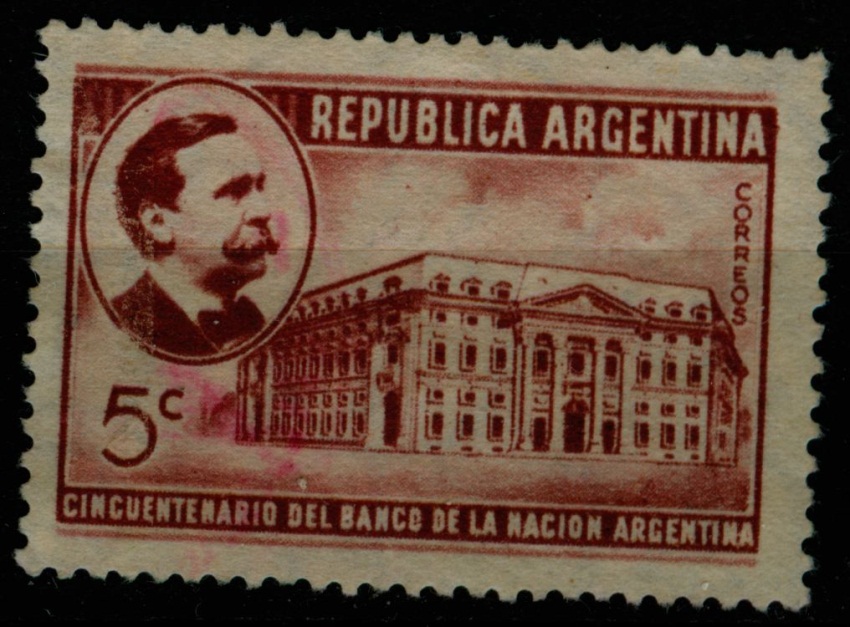
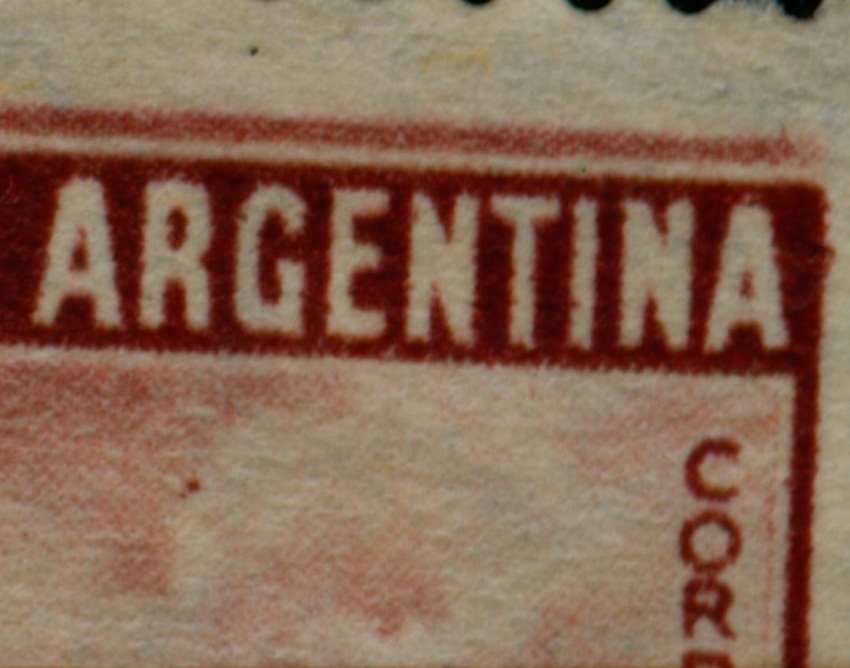
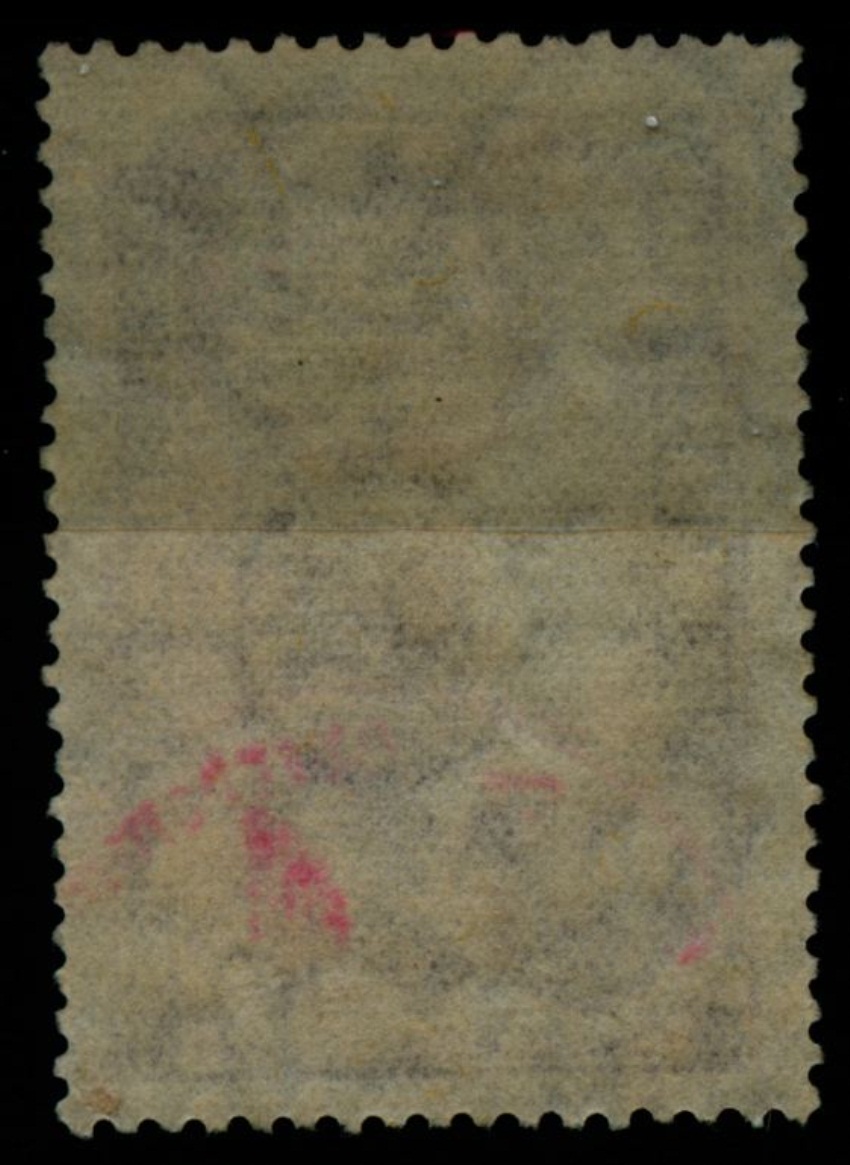
to be continued ...
- Rein
- Usuario Colaborador

- Mensajes: 6258
- Registrado: 13 Mar 2009 15:59
- Ubicación: Leiden, Netherlands
- Contactar:
Re: Tizado malinterpretado
What could be seen in the previous scan of the 5c Banco Nacional were the yellow/orange fibers!
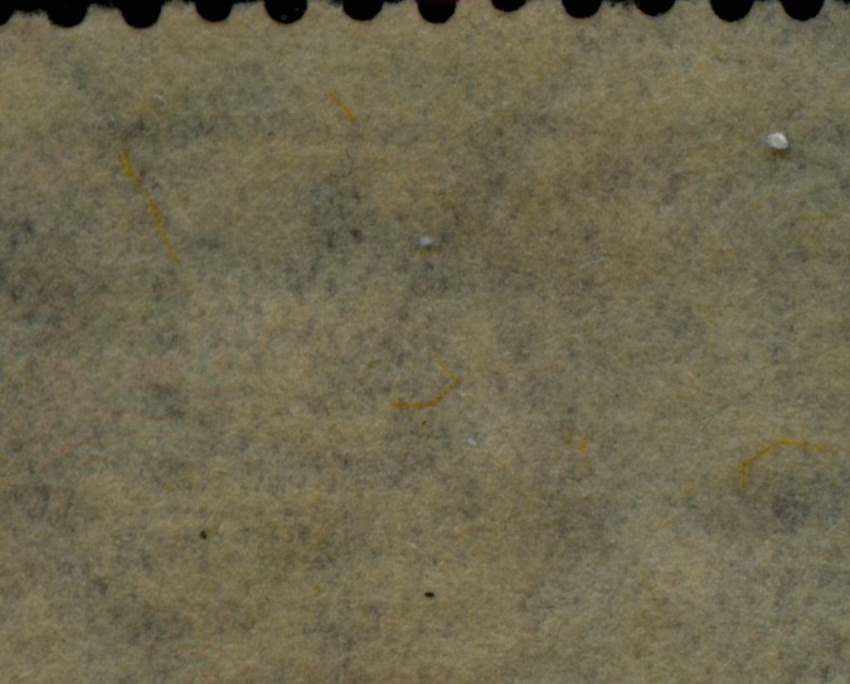
to be continued ...

to be continued ...
- Rein
- Usuario Colaborador

- Mensajes: 6258
- Registrado: 13 Mar 2009 15:59
- Ubicación: Leiden, Netherlands
- Contactar:
Re: Tizado malinterpretado
Should we have a tête-bêche lay-out for the 5c Roca then we can expect more or less equal numbers for both directions of printing!
This turns out to be not the case!
Out of the 61 used copies there are 11 with L and 50 with R!
The direction of printing R:
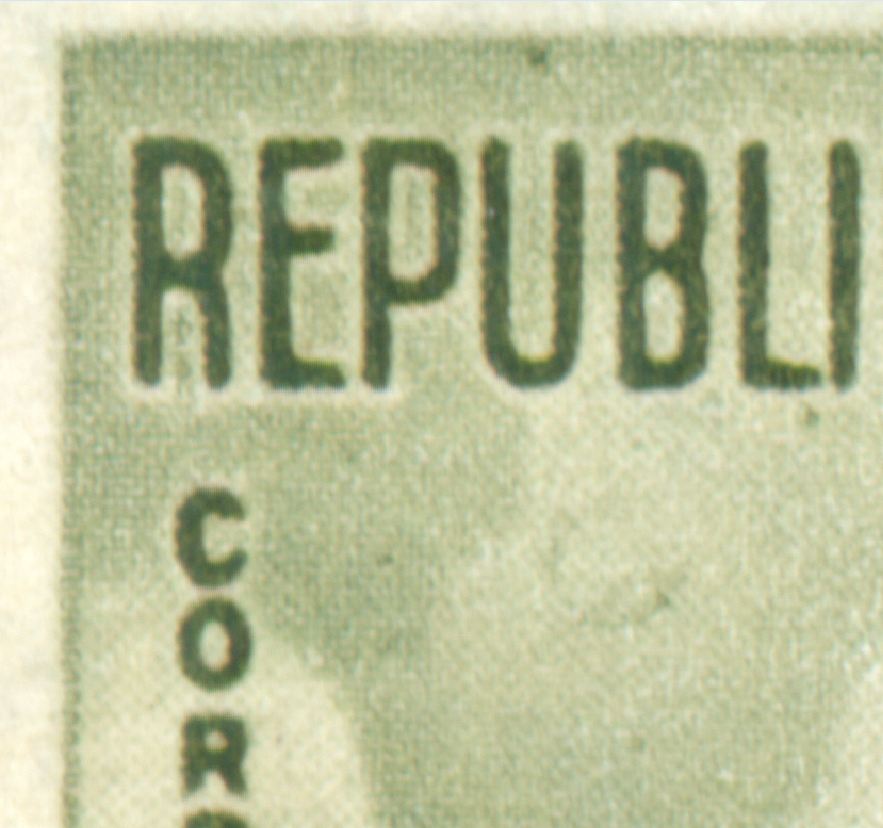
The direction of printing L:
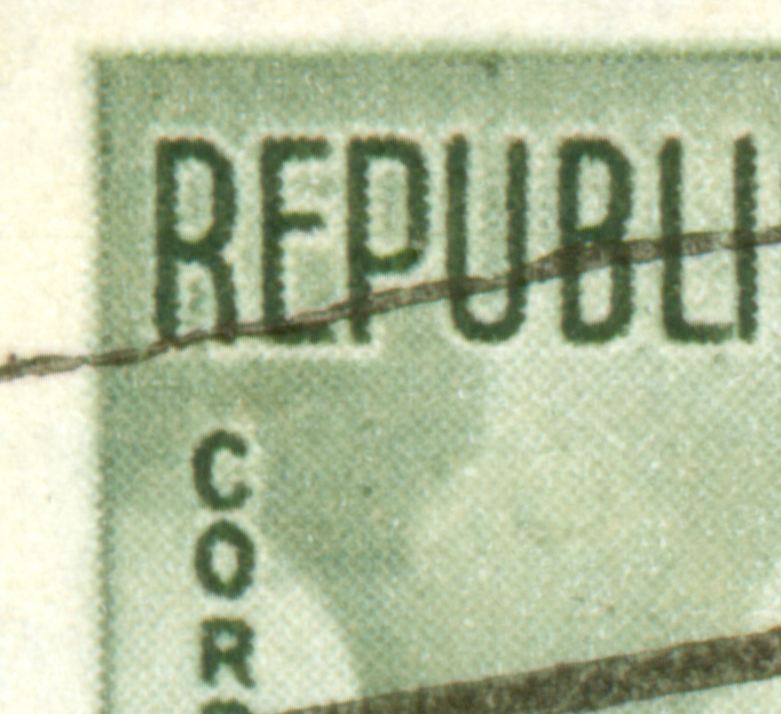
to be continued ...
This turns out to be not the case!
Out of the 61 used copies there are 11 with L and 50 with R!
The direction of printing R:

The direction of printing L:

to be continued ...
- Rein
- Usuario Colaborador

- Mensajes: 6258
- Registrado: 13 Mar 2009 15:59
- Ubicación: Leiden, Netherlands
- Contactar:
Re: Tizado malinterpretado
Both pictures reveal another peculiar thing! Remnants of the assumed root block! Assumed as we can only guess that in photogravure we had a similar process of making up a plate/cylinder as in offset-litho!
The direction of printing R:
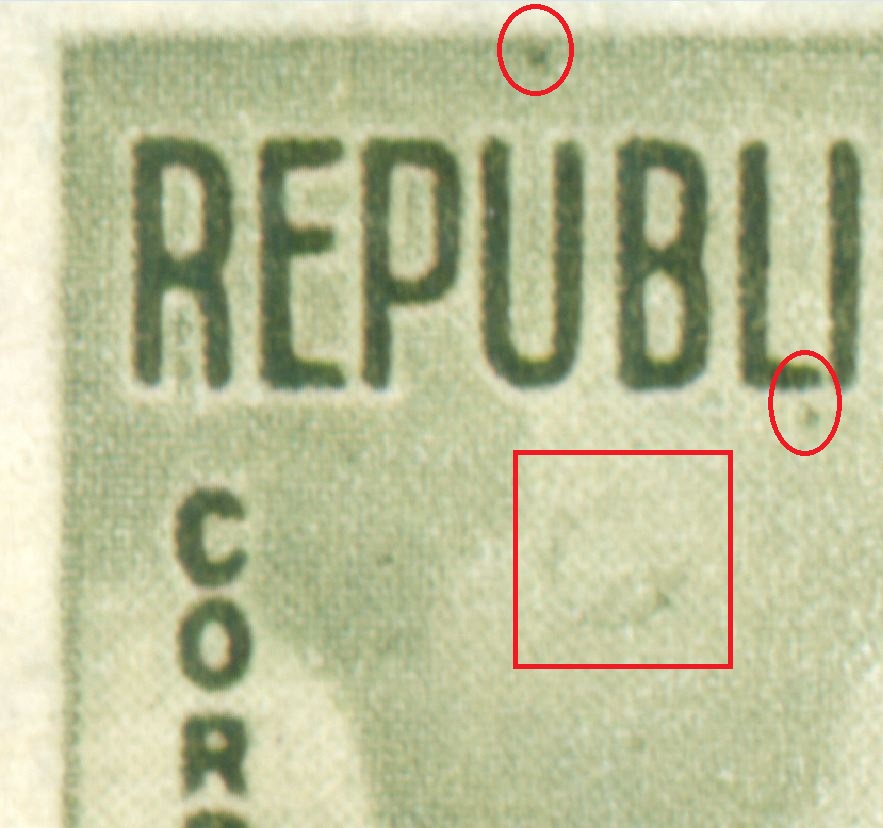
The direction of printing L:
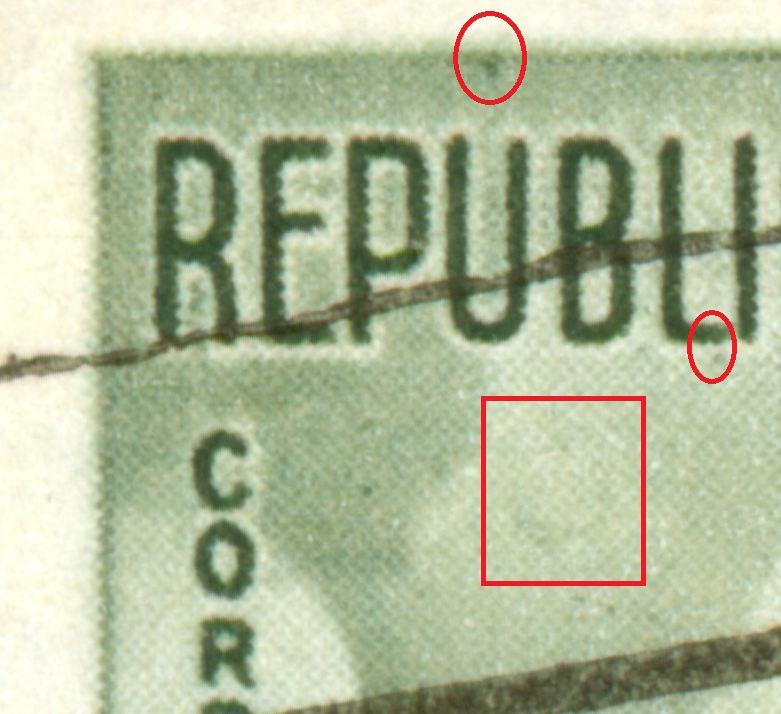
In both stamps we see tiny characteristics a.o.a round "necklace" underneath the "UB"...
This characteristic occurs 3 times in the 11 copies with L!!!!!
to be continued ...
The direction of printing R:

The direction of printing L:

In both stamps we see tiny characteristics a.o.a round "necklace" underneath the "UB"...
This characteristic occurs 3 times in the 11 copies with L!!!!!
to be continued ...
- Rein
- Usuario Colaborador

- Mensajes: 6258
- Registrado: 13 Mar 2009 15:59
- Ubicación: Leiden, Netherlands
- Contactar:
Re: Tizado malinterpretado
Another characteristics with the direction of printing L:
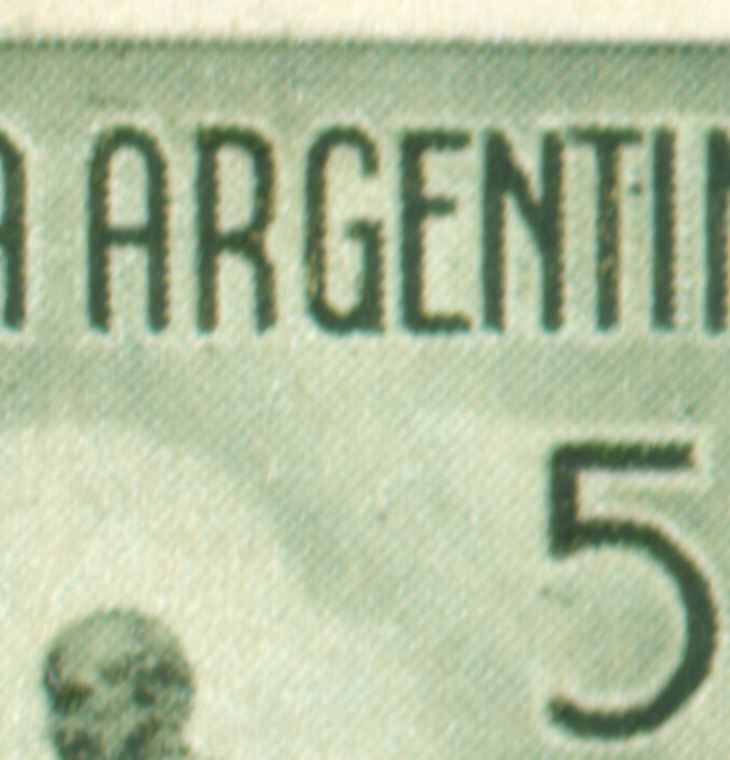
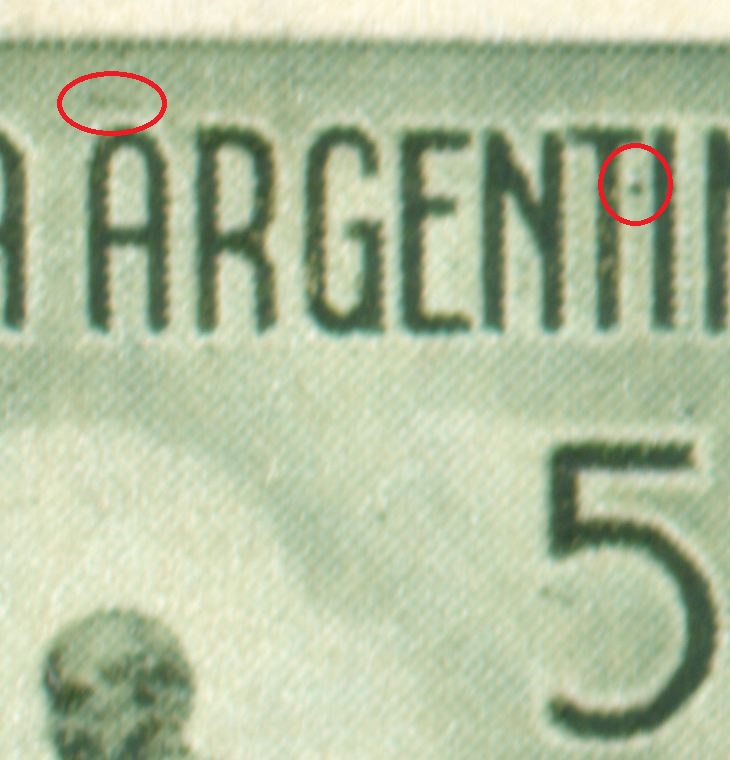
An "accent" on the first "A" of "Argentina"!
This characteristic occurs 10 times in the 50 copies I have with R!!!!!
to be continued ...


An "accent" on the first "A" of "Argentina"!
This characteristic occurs 10 times in the 50 copies I have with R!!!!!
to be continued ...
- Rein
- Usuario Colaborador

- Mensajes: 6258
- Registrado: 13 Mar 2009 15:59
- Ubicación: Leiden, Netherlands
- Contactar:
Re: Tizado malinterpretado
Preliminary conclusion of the previous postings!
There were (at least) 2 printings of the 5c Roca and both had cylinders made by a step-and-repeat process having the same root block!
to be continued ...
There were (at least) 2 printings of the 5c Roca and both had cylinders made by a step-and-repeat process having the same root block!
to be continued ...
Re: Tizado malinterpretado
Rein,
Paper Nº 27 and 27a belongs to a size of paper and not to a supplier. In think I told you this long ago. In this case those numbers were assigned to a new size of paper reels as the new size of typographed stamps reel fed were obviously different
from the JSM typo stamps.
On the other hand I do not discard the possibility of root blocks being used. I will confirm this in my next visit to CdM. It`s a pity they don`t anylonger keep the "approved" sheets, name they used to use to refer to the whole "pliego" containing 2 or more compositions which allowed you to see if it existed in Tête-Bêche. They called "aprobado" because it contained the signatures of Post Office and CdM officials giving the OK for definitive printing. Now they keep only one sheet of the 2 or 4 the pliego could contain.
What keeps me amazed is how you can find, in the Northen emisphere, the color fibers, but I wellcome that findings if they can contribute to identify origin of papers. Saludos a todos,
José
Paper Nº 27 and 27a belongs to a size of paper and not to a supplier. In think I told you this long ago. In this case those numbers were assigned to a new size of paper reels as the new size of typographed stamps reel fed were obviously different
from the JSM typo stamps.
On the other hand I do not discard the possibility of root blocks being used. I will confirm this in my next visit to CdM. It`s a pity they don`t anylonger keep the "approved" sheets, name they used to use to refer to the whole "pliego" containing 2 or more compositions which allowed you to see if it existed in Tête-Bêche. They called "aprobado" because it contained the signatures of Post Office and CdM officials giving the OK for definitive printing. Now they keep only one sheet of the 2 or 4 the pliego could contain.
What keeps me amazed is how you can find, in the Northen emisphere, the color fibers, but I wellcome that findings if they can contribute to identify origin of papers. Saludos a todos,
José
- Rein
- Usuario Colaborador

- Mensajes: 6258
- Registrado: 13 Mar 2009 15:59
- Ubicación: Leiden, Netherlands
- Contactar:
Re: Tizado malinterpretado
José,Otin escribió:Rein,
Paper Nº 27 and 27a belongs to a size of paper and not to a supplier. In think I told you this long ago. In this case those numbers were assigned to a new size of paper reels as the new size of typographed stamps reel fed were obviously different
from the JSM typo stamps.
On the other hand I do not discard the possibility of root blocks being used. I will confirm this in my next visit to CdM. It`s a pity they don`t anylonger keep the "approved" sheets, name they used to use to refer to the whole "pliego" containing 2 or more compositions which allowed you to see if it existed in Tête-Bêche. They called "aprobado" because it contained the signatures of Post Office and CdM officials giving the OK for definitive printing. Now they keep only one sheet of the 2 or 4 the pliego could contain.
What keeps me amazed is how you can find, in the Northen emisphere, the color fibers, but I wellcome that findings if they can contribute to identify origin of papers. Saludos a todos,
José
I am very well aware of the approval sheets! We do have them -fortunately - in our Museum of Communication in the Hague of most of the Dutch stamps! They do help but as they usually did not keep printing sheets of subsequent printings this help is only partial...
saludos, Rein